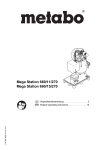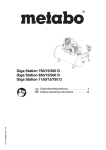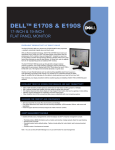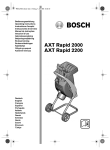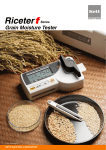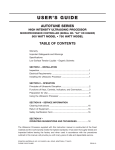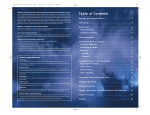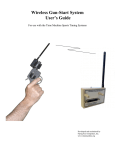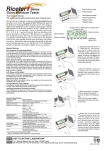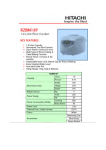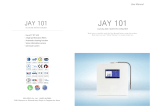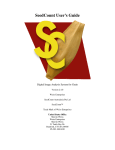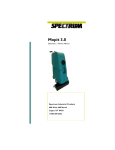Download RN-300 E Catalog Rev0101
Transcript
●The development of Kett Grain Quality Analyzer has been ongoing since 1984. First on the RH-100 model, then in 1987 on RH-200, 1993 on RN-500, 2001 on RN-300 early type, 2002 on RN-310 and 2003 on RN-300 late type. The development continues. RN -300 GRAIN QUALITY ANALYZER ● RN-300 carrying status ● RN-300 the side pocket opened ● RN-300 ready for use ●This instrument was developed under Japan's research and development project for inspection instruments. ●Japan Mizuho Food Inspection Association approves this instrument with approval number 030101, 2/5/2003 for Uruchi (Japonica) brown rice ●RN-300 Specifications Inspection Method Video scan method ● RN-300 in use ● Optional grain sorter TZ-700 ● Related instrument, Component Analyzer AN-800 Video picture analysis with a PC, exclusive software and video scan camera Pictures taken by scanning reader head Light source: White cold cathode fluorescent lamp Sensor: Color CCD Grains to measure Brown rice & Polished rice (Polished rice is optional) Inspection Modes Approval Mode (Basic 3 classifications), General Mode (3 in Basic, 6 in Standard and 21 in Fine) ● 3 in Basic---Even (Integral), Cracked and Other Grain quality to be classified Brown Rice: (Polished rice is optional) ● 6 in Standard---Even (Integral), Immature, Dead, Discolored, Cracked, and Damaged (Other than cracked) ● 21 in Fine---Finer classification than above 6 criterion. With or without abrasion in "Even(Integral)". Milky white, Stem immature, Green, Core white, Belly white and other in "Immature". Dead white, Dead green in "Dead". Total discoloring, Partial discoloring and Reddish in "Discolored". Germinated, Bad germ, Cracked, Deformed, Bug damaged, Lesion damaged, Crushed and dark in "Damaged". ● 4 in Basic---Normal, Crushed, Discolored and Other Polished Rice: ● 6 in Standard---Correct, Powdered quality, Damaged, Crushed, Discolored and Heterogeneous. ● 17 in Fine---Finer classification than above 6. Correct: No germ, Germ remains, Germ smooth, and Germ protoplasmic. Powdered quality: Totally powdered, Half powdered, Core white, and Belly white. Damaged: Hurt, Deformed, Other damage, and Crushed. Discolored: Totally discolored, Stink bug colored, Nematode colored, Lesion colored and Heterogeneous. ● Cracked grain ● Germ remaining rate and Remaining germ (Germ 0, Germ 1/2 and Germ 1) Grain shape measurement Length, Width and Projected area size Inspection number of grains 1~1,148 grains (1.148 is the full load on the measurementtray.) Processing ability 1,148 grains/approx. 24sec Display Contents Inspection results Number of grains, Composition rate (Grain number in %, Mass converted in %) and Histogram of Shape analysis for each classification criterion Picture Video picture, 50%~300% size display with sort layout function Numeric data Quality, Typification rate, Length, Width and Projected area size of each grain. Display Method TFT LCD Monitor CPU Intel Pentium 3 Software OS Windows XP, Microsoft Office, Application software "Kett Quality Scan" Memory Device HDD 40GB Data Save 10,000 (i.e. pictures and texts for 10,000 measurement trays) in MS Excel format except the pictures. Input/Output Terminal USB2.0 Terminal, LAN Terminal (Ethernet) Temp. and Humidity 5~35 Centigrade(41~95F), 10~80% Without condensation Environment for use Temp. and Humidity Environment for storage -25~60 Centigrade(-13~140F), 10~85% Without condensation Power Source Power Consumption Size, Weight AC100V±10% 50/60Hz 100VA when in use Carrying status: 580(W) ×230 (D)×420 (H) mm In use: 840(W) ×580(D)×115(H) mm, Approx. 12 Kg Measurement tray, Tray cover, Printer, Liner brush, Spray cleaner User's manual Grain liner TZ-700, External memory device(Compact HDD with USB cord), Additional measurement tray, USB-RS-232C Conversion cable, USB hub, Packaged software "Kett Quality Print" Pre-install software "Kett Quality Scan + DB Server" "Kett Quality Scan + DB Server" should be installed by the manufacturer. Please contact us for details. Cable-up configuration with Kett Component Analyzer AN-800 to integrate inner quality and appearance quality inspections. This will create a total quality evaluation system. Accessory Option Other function ●Windows XP, Office, Excel are trademarks of Microsoft Corporation. Intel Pentium 3 is a trademark of Intel Corporation. ●"Kett Quality Scan", "Kett Quality Print" and "Kett Quality Scan + DB Server" are product names of Kett Electric Laboratory. ●The specifications and/or format of the laptop PC required for use with RN-300 may change without notice. ●The color of the laptop PC may look different on this brochure. KETT ELECTRIC LABORATORY 1 - 8 - 1 M i n a m i - m a g o m e O t a - k u , To k yo 1 4 3 - 8 5 0 7 Ja p a n Tel.+81-3-3776-1121 Fax.+81-3-3772-3001 URL http://www.kett.co.jp/ E-mail [email protected] This brochure is printed by environmetally "Waterless Print" using "Vegetable Soy Oil" lnk on 100% recycled paper. ●Contact us at above addresses or by Email. URL: http://www.kett.co.jp/ Email: [email protected] ●The specifications and/or appearance of the product are subjected to change without notice for improvement. The color of the product may look different on this brochure. 0501 TO 0101 001K SCIENCE OF SENSING KETT ELECTRIC LABORATORY Grain Quality Analyzer RN-300, ALL IN ONE SPEC ANALYZER IS POPULAR AT ANY SITE. GRAIN QUALITY ANALYZER RN -300 It thoroughly inspects the external appearance of rice grain. ●This instrument was developed under Japan's research and development project for inspection instruments. ●Japan Mizuho Food Inspection Association approves this instrument with approval number 030101, 2/5/2003 for Uruchi (Japonica) brown rice ■ State of the art hardware is faithful to the human eye. It watches samples by observing reflectance and transmittance, like a human eye does. ●All-in-one type instrument. You can measure, display and print out at the site Camera, laptop PC, color LCD monitor and printer are all part of the one instrument. You don't have to connect any cables nor buy any software. You can measure, check on-screen, evaluate and file. External terminals are equipped as standard. ●The featured measurement tray system is free from mechanical troubles and minimizes optical contamination. Since contamination of the sensor is fatal to the instrument, the sensor unit of RN-300 is completely separated from the sample and is enclosed in glass. This frees the optical measurement system from performance setbacks and mechanical troubles due to contamination. The measurement tray is very easy to clean up. ●Optical Measurement Reflector System Body Rice Sample The sensor unit scans Tray the sample to receive Glass the RGB signals from it. The travel of the RGB mechanism is deCCD signed to be small to Software LCD minimize vibration, so Light Source Mirror Sensor Picture that an accurate picture may be obtained. Light Source + Sensor Unit Movement ●"Approval Mode" and "General Mode" selectable "Approval Mode" classifies the brown rice grains in three criteria: ""Even (Integral)", "Cracked", and "Other" in accordance with the analyzed values of criteria approved by the Japan Food Inspection Association. "General Mode" can classify it more finely up to a maximum of 21 criteria. ● You can construct a greater database The numeric data may be filed in MS Excel format to use as a database. Additionally, you can construct an even greater database using other database application software or the optional pre-install software "Kett Quality Scan + DB Server" which works in accordance with the DLL format of the developing environment. Contact us for the database construction details. ● The simple display is not a burden to the operator Kett Quality Scan starts with the analyzer power being turned on. The graphical user-friendly interface ensures easy operation. Just click the "Measurement" button for normal use and select the functions with the "Select" button. ●Network capability is standard A LAN terminal is equipped as standard. It enables you to share data, use a printer or access the Internet. ●Emulating human eye observation is the target of the instrument Kett's technical experience and know-how developed the RN-300 to display not only the numeric values as before but also the real video picture of the grains. This highly integrated hardware and software now shows you an image of the grains true to human eye observation. This is made possible by state of the art video picture technology and the exclusive software "Kett Quality Scan". ● Displays data that fits the work at any site The analyzer displays detailed data and pictures that are wanted at your harvest site. In addition to the pictures, the amount of grains and the rate of composition (grain amount in %, mass converted in %) are displayed for each classified criterion. It also displays the histogram of the grain shape analysis for you to confirm the uniformity of the grains. Each grain's quality, typification rate, length, width, projected area size, etc. will also be displayed for you to see and utilize for your future farming projects and/or breed refinement. ●Sure and versatile calibration function The calibration function allows you to adjust the analyzer in case you want to modify the accuracy or the result. It also allows you to adjust the measurement for unusual samples, where a normal analyzing function may not be suitable. You can adjust the analyzer's inspection level to correspond to a sample of which the component rate is already known. ● MS Excel format automatic save All numerical measurement data with the date, time and the sample number can be saved automatically in MS Excel format. You can use the data as is or edit it to suit your needs for your reference. All the data of the grain components can be saved together in the same format when the instrument is connected with the component analyzer AN-800. ●Numeric printer as standard, color printer optional Numeric data can be printed out on the spot from the attached standard printer. Color pictures can be printed out with "Kett Quality Print", the optional color printing application. Here is a preview of the on-screen display of the print menu and an example of a printout. ● Picture analysis The shape and color analysis are carried out using the detected RGB signals. The size, length, width and proportion of each grain can be calculated from the pixel number data. And from the color data discoloration, partial discoloration, etc. can be detected. The color distribution pattern allows recognition of "Even", "Immature", "Damaged", etc. The changes of color concentration allow the instrument to recognize "Cracked", "Scraped surface", "Partially discolored", "Germinated", "Unpolished (Germ remaining)", etc. ●You can construct an integrated quality grading system Connect with the Kett Component Analyzer AN-800 to measure the inner quality and build up your own "Rice quality grading system". AN-800 allows you to view water content, protein, amylase and fatty acid (only in brown rice) of brown or polished rice. ●One-to-one correlation of the sample and its picture One measurement tray has 1148 (1152 minus 4) holes to line up sample grains in 32 lines by 36 rows. Each hole has an address. Each picture taken during measurement will be displayed with its corresponding address. [22-3] means the sample is located in the hole on the 22nd line, 3rd row from the right. You can actually see and refer the picture to the measurement data. ■ "Kett Quality Scan" is the software suitable for use at any site. ●Brown rice and polished rice can be inspected in detail. The quality of brown rice grain can be classified with 3 criteria at "Basic" setting, 6 at "Standard", 21 at "Fine". For polished rice (optional) the following criteria are available: basic 4, standard 6 and fine 17. Furthermore, remaining rate of germ can be displayed. The Japan Polished Rice Industrial Association and Kett coordinated to develop these criteria for polished rice. ●Featuring a high performance laptop PC with large capacity hardware The high performance laptop allows quick and easy processing of picture data. 10,000 pictures of the measurement tray and the corresponding numeric data of the measurements can be stored in the HD memory. ●Tray measurement method ensures efficiency and practical application Being able to prepare more than one measurement tray allows a highly efficient measurement when measuring various kinds of samples. It also makes it easier for you to compare untested samples with ones you have already measured. The automatic grain line former, TZ-700, is available as an option. RN-300 inspects and analyzes rice grain in a very similar manner to the human eye. It displays its measurement results in numeric data and video pictures. RN-300 is a portable machine. An excellent optical measurement system combined with easily operated software makes it the best partner for your rice quality evaluation. On-screen display of the print menu by "Kett Quality Print" software. Example of a printout by the attached printer. ●The analyzed data will be displayed on the standard color monitor The detected picture and the numeric data will be displayed on the TFT LCD screen. The color and shape are true to the sample. You can easily look at the sample to compare it with the picture taken. During measurement you can always check by comparing the inspection of the analyzer to an inspection by the human eye. ●24 sec. high speed process for data and picture display The instrument takes only approx. 24 seconds to display the analyzed numeric data and the detected pictures of all 1,148 grains. For the rice grain quality inspection, it is important to do a quick comparison check between the human eye and the analyzer results. You can do several comparisons using different people to confirm the analyzer's data. Picture image processing ● Displays shown by the Kett Quality Scan ■ Thumbnail screen ■ Starting screen Pictures of the sample appear on the left, This display appears first when the power is measured numeric data on the right of the turned on. Select either "Approval Mode" or screen. Numeric data includes crosswise grid "General Mode". Also select brown rice or polnumber, quality, typification rate, length, width ished rice (polished rice optional). and projected size of all the grains. This may be sorted to suit selected conditions. RGB signal concentration distribution ■ Inspection result screen (Generic Mode) ■ Inspection result screen (Approval Mode) On the upper left appears the histogram of the On the upper left appears the histogram of the shape analysis of the sample. On the right the shape analysis of the sample. On the right the amount of grains, mass converted to % for each amount of grains, mass converted to % or the of the 3 classified criteria. grain amount in % for each classified criterion. You can change the display from/to "Normal", "Standard" and "Fine". ● Standard 6 classifications inspected by Kett Quality Scan ● Brown rice quality can be classified in 3 classes at "Basic", 6 at "Standard" and 21 at "Fine". ● Reflectance and the transmittance method (The glass, mirror and lens are not drawn in the illustration below.) The optical system detects not only the front of the grain but also the color of the other side and/or cracks inside the grain. (It is a simple mechanism that functions similarly to human eye observation.) Reflector Rice Reflector Reflector Sample tray Rice Sample tray Rice Reflector Sample tray Rice Sample tray ●Even, (Integral) ●Immature ●Dead ●Discolored ●Damaged (Cracked) ●Damaged (Deformed) ● Polished rice quality can be classified in 4 classes at "Basic", 6 at "Standard" and 17 at "Fine". Light source RGB CCD ■ Even (Integral) grain Light reflects on the grain surface and reaches the RGB sensor. Light passes through the grain, is reflected by the reflector and, passing through the grain again, reaches the RGB sensor. Light source RGB CCD ■ Discolored grain (Upper side) Light reflects on the rice grain surface and reaches the RGB sensor. Light passes through the grain and is colored before being reflected by the reflector and, passing through the grain again, reaches the RGB sensor. Light source RGB CCD ■ Discolored grain (Lower side) Light reflects on the colored surface of the grain and reaches the RGB sensor. Light passes through the grain, is reflected by the reflector and, passing through the grain again, reaches the RGB sensor. Light source RGB CCD ■ Cracked grain Light reflects on the grain surface and reaches the RGB sensor. Light is diffused and diminished while passing through the crack and, reflected by the reflector, reaches the RGB sensor. ●Normal ●Powdered quality ●Damaged ●Discolored ●Crushed ●Heterogeneous (Glutinous rice, etc)


